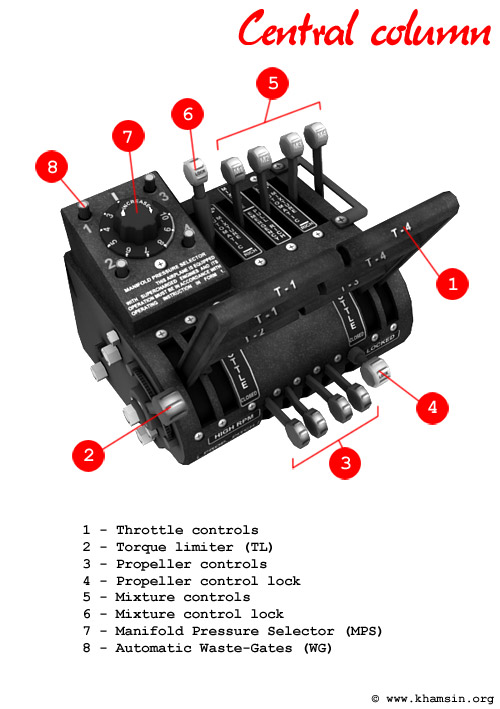
Pedestal
From V1.1 version, calibration is no longer mandatory unlike what is mentionned below. Nonetheless, il remains very useful.
The central column (« or pedestal » ) places the following engines controls in a central area : throttle control, propeller control, mixture control, and super-charger control.
Where they exist, multiple controls are labeled 1 to 4 according to the engine it refers to, with (conventionally) engine 1 being the left outboard unit, engine 2 inboard left, engine 3 inboard right, and engine 4 the right-outboard unit.
A.1 - PROPELLERS CONTROLS
Propellers are manufactured by Hamilton-Standard; they are automatic, constant-speed, equipped with an electrically powered, built-in anti-ice system. PROP rotation speed is controlled by the PROP control levers on the central pedestal, and synchronization can be locked and unlocked through the « lock » handle on the right side of the rpm-control handles.
With the PROP handle in the DOWN position, propellers pitch is blocked in its current position. The pilot can feather a propeller simply pushing dedicated red button on the instruments panel.
NB : Feathering a prop will stall the engine if the manifold pressure is too low – i.e., below 30 inches of mercury.
NB2 : Prop de-ice is triggered via a switch on the overhead panel.
A.2 - HANDLING THE SUPERCHARCHER
[IMPORTANT] The super-charger MUST be calibered before engines are started. This was true In Real Life, but as well it is needed to avoid systems’ malfunctions in X-PLANE when you fly the plane at very high altitude (e.g., >25000ft). This action MUST be accomplished on the ground and BEFORE main engine start-up. [IMPORTANT NOTE] When ON, waste-gates prevent the manifold gauges from displaying more than 46 inches of mercury, regardless of other engine settings. If a WG is turned OFF at low altitude with the throttle fully open, the engine might suddenly display a manifold pressure that could be much higher than indicated, causing severe engine damage. The engine will very likely be unusable for the rest of your flight. This version introduces a much more realistic use of the Manifold Pressure Selector, also known as "SuperCharger". If you are used with the v1.0 of the B17, probably, you should read the following carefully. The MPS allows the pilot to boost the pressure inside the engine, thus increasing the power at high heights. The counterpart is, at low heights, it's possible to damage the engines by over-pressuring them. To avoid this, there is a Waste Gate for each engine. In the previous version of the plane, this was basically custom fadec's, but now, the plugin simulates the individual behaviour of each engine. This basically means that damaging an engine by mis-managing it is still possible, but the effects will be slighty different. The MPS now really acts as it is supposed to : it will set a maximum manifold pressure, and this MP has to be adjusted individually for each engine with the throttles. To protect the engines at low heights, the pilot must open the waste-gates, which are essentially valves automatically opening to release the over-pressure. Now, here is the trick : these valves are set to open slighty BELOW the nominal power of the engine, and they open all the more that the pressure is high. In other words, the more you push the throttle and/or the MPS, the more the valves will open, resulting in a creepy running of the engines if you are far above the limits. Plus, you cannot achieve max power with the waste-gate open. So, if your engine goes creepy with unstable manifold pressure, you should not close the waste-gate "to see what happens", you should instead lower your MPS/throttle settings, slowly. When the engine runs smoothly, you have set the maximum allowable power achievable with waste-gate activated. The WG should be closed for take off, to be able to achieve max power ; if the runway is very long, you can let them open. The WG can be closed quite securely above 12000 or 15000 ft, depending on the external atmospheric pressure. If you do overcharge an engine with the waste-gate CLOSED, the engine will NOT fail but the waste-gate itself eventually will, breaking wide open, resulting in an engine that is still alive but can't build up manifold pressure any longer. This engine is to be considered as supplying no thrust. It's very likely to eventually stop. The B17G is equiped with a fully-automated fuel/air mixture system. This automated system enables the plane to fly with an ideal mixture whatever the altitude. Nevertheless, it IS possible to disengage the automatic system and operate the mixture controls by hand, and this may prove useful if an engine fails or is battle-damaged and catches on fire. To disengage the automatic system, the pilot simply has to PULL the « lock » handle on the left side of the mixture control handles (the red headed handles) to disengage the system. NB : If the mixture is set by hand, it MUST be leaned as the plane climbs, or fuel consumption will dramatically increase. Furthermore, available power will be inadequate to maintain level flight at high altitude. Typically, the practical ceiling will be 22000ft with mixture set to full rich, whereas with proper mixture settings maximum achievable service altitudes can approach 38000ft. Please note that on the fuel management switchbox there are 8 SWITCES related to controlling fuel flow: 4 are for primary fuel pumps, 4 drive opening and closing of the fuel injector pumps. Closing any one of fuel injector switches will cause the automated system to produce a FULL LEAN condition for that engine, thus stalling that engine. Closing a fuel pump switch will NOT stall the engine - it will simply lower the appropriate fuel pressure reading.
A.2.1 - Calibrating engine super-chargers
A.2.2 - USE OF SUPER-CHARGER :
A.3 - MIXTURE CONTROLS
www.khamsin.org - 2014-2017

